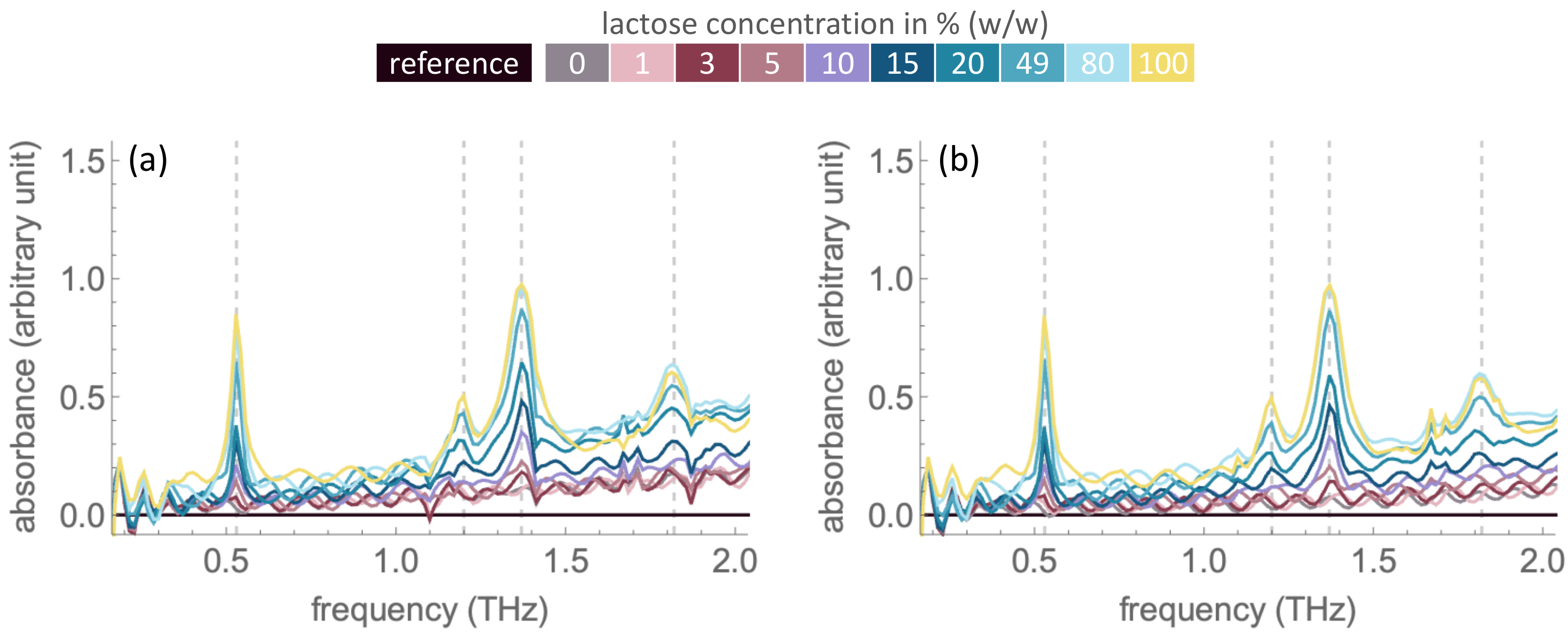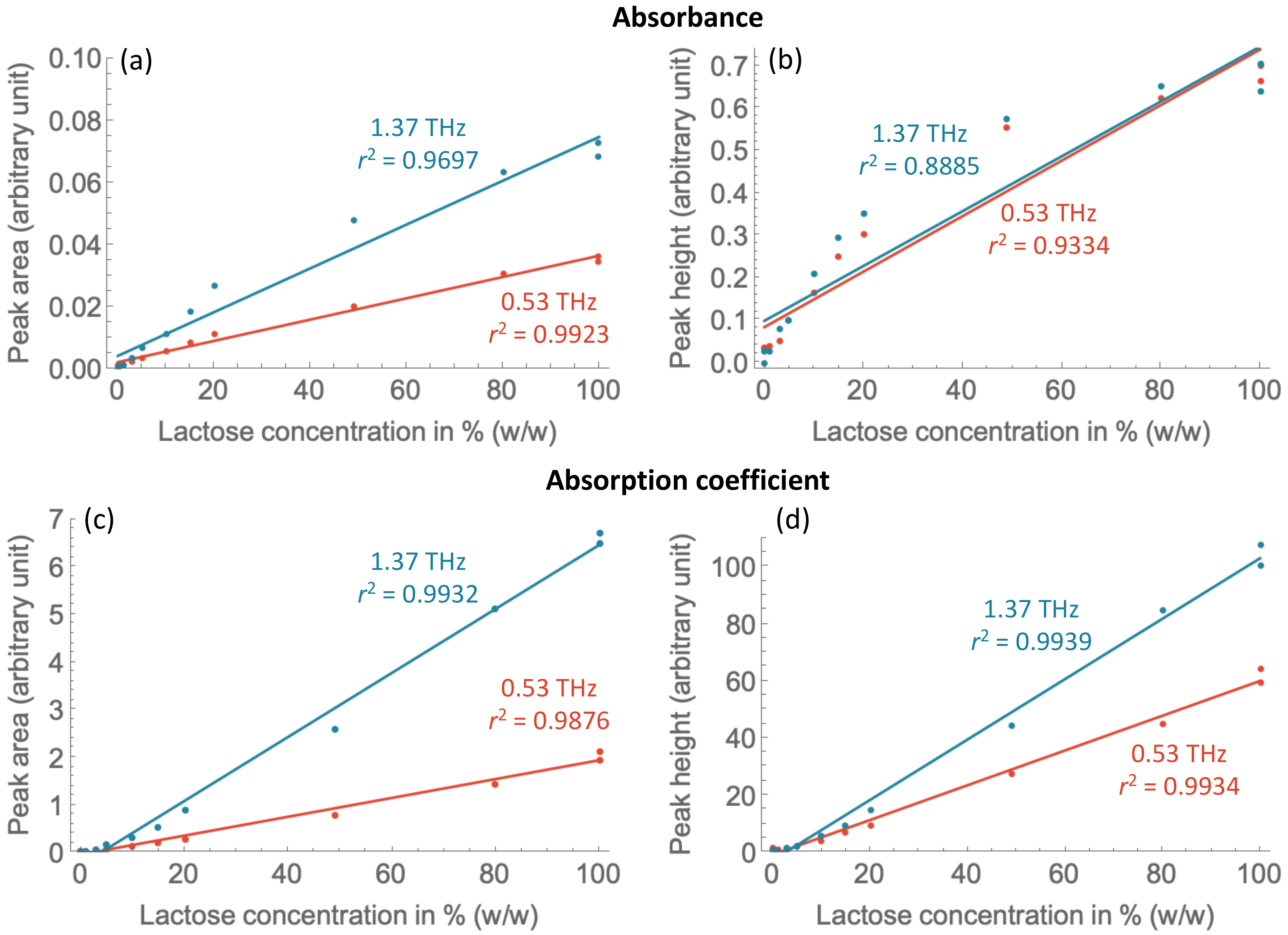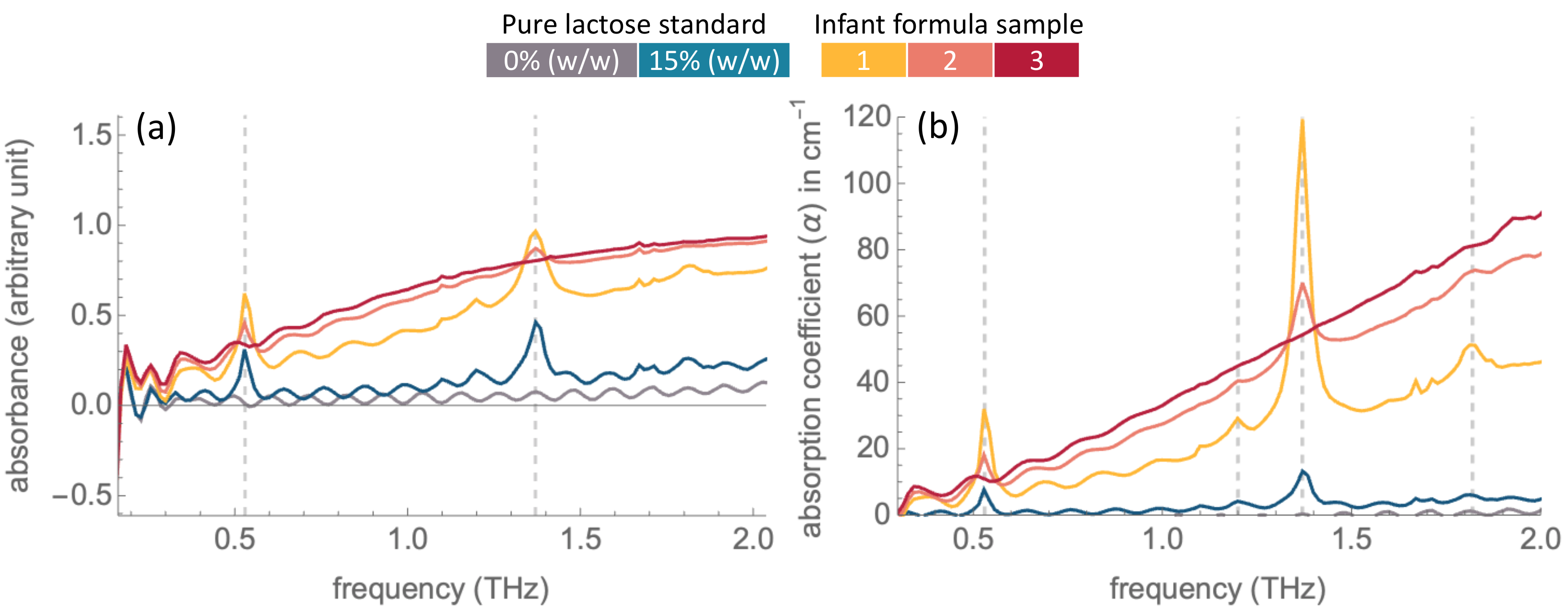Terahertz Spectroscopic Analysis of Lactose in Infant Formula: Implications for Detection and Quantification
Abstract
1. Introduction
2. Results and Discussion
2.1. Spectra of Pure Samples
2.2. Quantification Model
2.3. Application on Diary Product Samples
3. Materials and Methods
4. Conclusions
Supplementary Materials
Author Contributions
Funding
Institutional Review Board Statement
Informed Consent Statement
Data Availability Statement
Acknowledgments
Conflicts of Interest
Sample Availability Statement
References
- Food and Agriculture Organizaion. Gateway to Dairy Production and Products. Available online: https://www.fao.org/dairy-production-products/products/en/ (accessed on 2 March 2022).
- Fox, P.F.; Uniacke-Lowe, T.; McSweeney, P.L.H.; O’Mahony, J.A. Lactose. In Dairy Chemistry and Biochemistry; Fox, P.F., Uniacke-Lowe, T., McSweeney, P.L.H., O’Mahony, J.A., Eds.; Springer: Cham, Switzerland, 2015; pp. 21–68. [Google Scholar]
- National Institute of Diabetes and Digestive and Kidney Diseases. Lactose Intolerance. Available online: https://www.niddk.nih.gov/health-information/digestive-diseases/lactose-intolerance (accessed on 2 March 2022).
- Fox, P.F. Lactose: Chemistry and Properties. In Advanced Dairy Chemistry; McSweeney, P., Fox, P.F., Eds.; Springer: New York, NY, USA, 2009; pp. 1–15. [Google Scholar]
- Hebbink, G.A.; Dickhoff, B.H.J. Chapter 5—Application of lactose in the pharmaceutical industry. In Lactose; Paques, M., Lindner, C., Eds.; Academic Press: Cambridge, MA, USA, 2019; pp. 175–229. [Google Scholar]
- Paterson, A. Production and uses of lactose. In Advanced Dairy Chemistry; McSweeney, P., Fox, P.F., Eds.; Springer: New York, NY, USA, 2009; pp. 105–120. [Google Scholar]
- Churakova, E.; Peri, K.; Vis, J.S.; Smith, D.W.; Beam, J.M.; Vijverberg, M.P.; Stor, M.C.; Winter, R.T. Accurate analysis of residual lactose in low-lactose milk: Comparing a variety of analytical techniques. Int. Dairy J. 2019, 96, 126–131. [Google Scholar] [CrossRef]
- Eadala, P.; Waud, J.; Matthews, S.B.; Green, J.T.; Campbell, A.K. Quantifying the ‘hidden’ lactose in drugs used for the treatment of gastrointestinal conditions. Aliment. Pharmacol. Ther. 2009, 29, 677–687. [Google Scholar] [CrossRef] [PubMed]
- Garballo-Rubio, A.; Soto-Chinchilla, J.; Moreno, A.; Zafra-Gómez, A. Determination of residual lactose in lactose-free cow milk by hydrophilic interaction liquid chromatography (HILIC) coupled to tandem mass spectrometry. J. Food Compos. Anal. 2018, 66, 39–45. [Google Scholar] [CrossRef]
- Martínez-Aviñó, A.; Molins-Legua, C.; Campíns-Falcó, P. Combining high performance thin layer chromatography with minispectrometer-fiber optic probe-coupled to smartphone for in place analysis: Lactose quantification in several matrices. J. Chromatogr. A 2022, 1661, 462694. [Google Scholar] [CrossRef]
- Warnecke, S.; Wu, J.X.; Rinnan, Å.; Allesø, M.; van den Berg, F.; Jepsen, P.U.; Engelsen, S.B. Quantifying crystalline α-lactose monohydrate in amorphous lactose using terahertz time domain spectroscopy and near infrared spectroscopy. Vib. Spectrosc. 2019, 102, 39–46. [Google Scholar] [CrossRef]
- Monakhova, Y.B.; Kuballa, T.; Leitz, J.; Andlauer, C.; Lachenmeier, D.W. NMR spectroscopy as a screening tool to validate nutrition labeling of milk, lactose-free milk, and milk substitutes based on soy and grains. Dairy Sci. Technol. 2012, 92, 109–120. [Google Scholar] [CrossRef]
- Pokrzywnicka, M.; Koncki, R. Disaccharides determination: A review of analytical methods. Crit. Rev. Anal. Chem. 2018, 48, 186–213. [Google Scholar] [CrossRef]
- Bo, Y.; Fang, J.; Zhang, Z.; Xue, J.; Liu, J.; Hong, Z.; Du, Y. Terahertz and Raman Spectroscopic Investigation of Monohydrate Cocrystal of Antitubercular Isoniazid with Protocatechuic Acid. Pharmaceutics 2021, 13, 1303. [Google Scholar] [CrossRef]
- Hua, Y.; Zhang, H. Qualitative and quantitative detection of pesticides with terahertz time-domain spectroscopy. IEEE Trans. Microw. Theory Tech. 2010, 58, 2064–2070. [Google Scholar] [CrossRef]
- Im, J.; Goo, T.; Kim, J.; Choi, S.; Hong, S.J.; Bahk, Y.-M. Detection of Microplastic in Salts Using Terahertz Time-Domain Spectroscopy. Sensors 2021, 21, 3161. [Google Scholar] [CrossRef]
- Taday, P.F. Applications of terahertz spectroscopy to pharmaceutical sciences. Philos. Trans. R. Soc. London. Ser. A Math. Phys. Eng. Sci. 2004, 362, 351–364. [Google Scholar] [CrossRef] [PubMed]
- Yamauchi, S. Terahertz time-domain spectroscopy to identify and evaluate anomer in lactose. Am. J. Anal. Chem. 2013, 4, 756. [Google Scholar] [CrossRef][Green Version]
- Wang, Y.; Zhao, Z.; Qin, J.; Liu, H.; Liu, A.; Xu, M. Rapid in situ analysis of l-histidine and α-lactose in dietary supplements by fingerprint peaks using terahertz frequency-domain spectroscopy. Talanta 2020, 208, 120469. [Google Scholar] [CrossRef] [PubMed]
- McIntosh, A.I.; Yang, B.; Goldup, S.M.; Watkinson, M.; Donnan, R.S. Crystallization of amorphous lactose at high humidity studied by terahertz time domain spectroscopy. Chem. Phys. Lett. 2013, 558, 104–108. [Google Scholar] [CrossRef]
- Yamauchi, S.; Hatakeyama, S.; Imai, Y.; Tonouchi, M. Nondestructive evaluation of crystallized-particle size in lactose-powder by terahertz time-domain spectroscopy. Opt. Eng. 2013, 53, 031203. [Google Scholar] [CrossRef]
- Peretti, R.; Mitryukovskiy, S.; Froberger, K.; Mebarki, M.A.; Eliet, S.; Vanwolleghem, M.; Lampin, J.-F. THz-TDS time-trace analysis for the extraction of material and metamaterial parameters. IEEE Trans. Terahertz Sci. Technol. 2018, 9, 136–149. [Google Scholar] [CrossRef]
- Hou, L.; Shi, W.; Dong, C.; Yang, L.; Wang, Y.; Wang, H.; Hang, Y.; Xue, F. Probing trace lactose from aqueous solutions by terahertz time-domain spectroscopy. Spectrochim. Acta Part A Mol. Biomol. Spectrosc. 2021, 246, 119044. [Google Scholar] [CrossRef]
- Huang, H.; Shao, S.; Wang, G.; Ye, P.; Su, B.; Zhang, C. Terahertz spectral properties of glucose and two disaccharides in solid and liquid states. iScience 2022, 25, 104102. [Google Scholar] [CrossRef]
- Baranova, A.; Lykina, A.; Antonova, D.; Smolyanskaya, O. Optical Properties of Crystalline Lactose Fluidized with Dilutions of Various Substances in the Terahertz Frequency Range. Pharmaceutics 2022, 14, 32. [Google Scholar] [CrossRef]
- Namkung, H.; Kim, J.; Chung, H.; Arnold, M.A. Impact of pellet thickness on quantitative terahertz spectroscopy of solid samples in a polyethylene matrix. Anal. Chem. 2013, 85, 3674–3681. [Google Scholar] [CrossRef]
- Smith, G.; Hussain, A.; Bukhari, N.I.; Ermolina, I. Quantification of residual crystallinity in ball milled commercially sourced lactose monohydrate by thermo-analytical techniques and terahertz spectroscopy. Eur. J. Pharm. Biopharm. 2015, 92, 180–191. [Google Scholar] [CrossRef] [PubMed]
- Portnoy, M.; Barbano, D.M. Lactose: Use, measurement, and expression of results. J. Dairy Sci. 2021, 104, 8314–8325. [Google Scholar] [CrossRef]
- Altamimi, M.J.; Wolff, K.; Nokhodchi, A.; Martin, G.P.; Royall, P.G. Variability in the α and β anomer content of commercially available lactose. Int. J. Pharm. 2019, 555, 237–249. [Google Scholar] [CrossRef]
- Loahavilai, P.; Datta, S.; Kingkan, C.; Prasertsuk, K.; Jintamethasawat, R.; Rattanawan, P.; Chia, J.Y.; Thanapirom, C.; Limpanuparb, T. Chemometric Analysis of Ternary Mixture of Caffeine, Quinic Acid and Nicotinic Acid by Terahertz Spectroscopy. ACS Omega 2022. [Google Scholar] [CrossRef]
- Dorney, T.D.; Baraniuk, R.G.; Mittleman, D.M. Material parameter estimation with terahertz time-domain spectroscopy. JOSA A 2001, 18, 1562–1571. [Google Scholar] [CrossRef]
- Duvillaret, L.; Garet, F.; Coutaz, J.-L. A reliable method for extraction of material parameters in terahertz time-domain spectroscopy. IEEE J. Sel. Top. Quantum Electron. 1996, 2, 739–746. [Google Scholar] [CrossRef]
- Duvillaret, L.; Garet, F.; Coutaz, J.-L. Influence of noise on the characterization of materials by terahertz time-domain spectroscopy. JOSA B 2000, 17, 452–461. [Google Scholar] [CrossRef]




| Method | Principle | Sample Preparation | Reagents |
|---|---|---|---|
| chromatographic: HPLC, HILIC, HPTLC, HPAEC | separation of compounds based on polarity, electrical charge or molecular size | sample purification, solid removal | solvents |
| spectrophotometric | conversion of lactose into its monomers for further reactions, followed by spectrophotometric quantification | hydrolysis of lactose, addition of reagents | solvent, enzyme, oxidising agents |
| spectroscopic: NMR | determination of molecular structure through chemical shifts when magnetic field is applied | sample purification, solid removal | solvents |
| spectroscopic: NIR, THz | determination of molecular structure through molecular vibrations | grounding, water removal | - |
| Predictor | Absorption Peak | Equation of Trendline | RMSE | |
|---|---|---|---|---|
| Absorbance | Peak area | 0.53 THz | 3.43 × 10−4 x + 0.0021 | 0.0011 |
| 1.37 THz | 7.06 × 10−4 x + 0.0041 | 0.0047 | ||
| Peak height | 0.53 THz | 6.54 × 10−3 x + 0.0840 | 0.0664 | |
| 1.37 THz | 6.46 × 10−3 x + 0.0990 | 0.0870 | ||
| Absorption coefficient | Peak area | 0.53 THz | 1.98 × 10−2 x − 0.0288 | 0.0840 |
| 1.37 THz | 6.71 × 10−2 x − 0.2468 | 0.2127 | ||
| Peak height | 0.53 THz | 6.08 × 10−1 x − 0.6794 | 1.8840 | |
| 1.37 THz | 1.06 x − 2.6018 | 3.1344 | ||
| Mean Concentration ± SD in % (w/w) | ||||
|---|---|---|---|---|
| Sample 1 | Sample 2 | Sample 3 | ||
| Absorbance | 0.53 THz | 39.0 ± 1.6 | 1.8 ± 1.0 | –19.4 ± 1.5 |
| 1.37 THz | 45.1 ± 1.5 | 11.4 ± 0.7 | 0.0 ± 0.6 | |
| Absorption coefficient | 0.53 THz | 62.5 ± 4.4 | 23.6 ± 9.2 | 1.8 ± 10.1 |
| 1.37 THz | 68.4 ± 1.6 | 20.8 ± 0.5 | not detected * | |
| HPLC (from external laboratories) | 61.97 (n = 2) | 59.97 (n = 3) | not done | |
| Product label: carbohydrate content | 60 | 58 | assumed to be 0 (lactose-free) | |
Publisher’s Note: MDPI stays neutral with regard to jurisdictional claims in published maps and institutional affiliations. |
© 2022 by the authors. Licensee MDPI, Basel, Switzerland. This article is an open access article distributed under the terms and conditions of the Creative Commons Attribution (CC BY) license (https://creativecommons.org/licenses/by/4.0/).
Share and Cite
Datta, S.; Prasertsuk, K.; Khammata, N.; Rattanawan, P.; Chia, J.Y.; Jintamethasawat, R.; Chulapakorn, T.; Limpanuparb, T. Terahertz Spectroscopic Analysis of Lactose in Infant Formula: Implications for Detection and Quantification. Molecules 2022, 27, 5040. https://doi.org/10.3390/molecules27155040
Datta S, Prasertsuk K, Khammata N, Rattanawan P, Chia JY, Jintamethasawat R, Chulapakorn T, Limpanuparb T. Terahertz Spectroscopic Analysis of Lactose in Infant Formula: Implications for Detection and Quantification. Molecules. 2022; 27(15):5040. https://doi.org/10.3390/molecules27155040
Chicago/Turabian StyleDatta, Sopanant, Kiattiwut Prasertsuk, Nuttawat Khammata, Patharakorn Rattanawan, Jia Yi Chia, Rungroj Jintamethasawat, Thawatchart Chulapakorn, and Taweetham Limpanuparb. 2022. "Terahertz Spectroscopic Analysis of Lactose in Infant Formula: Implications for Detection and Quantification" Molecules 27, no. 15: 5040. https://doi.org/10.3390/molecules27155040
APA StyleDatta, S., Prasertsuk, K., Khammata, N., Rattanawan, P., Chia, J. Y., Jintamethasawat, R., Chulapakorn, T., & Limpanuparb, T. (2022). Terahertz Spectroscopic Analysis of Lactose in Infant Formula: Implications for Detection and Quantification. Molecules, 27(15), 5040. https://doi.org/10.3390/molecules27155040







